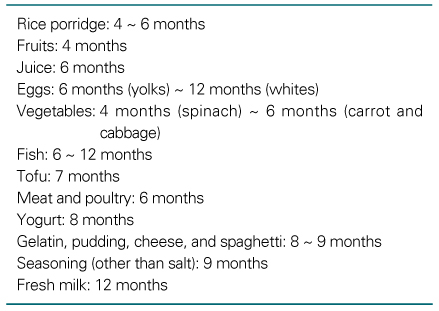 |
 |
- Search
| J Korean Med Assoc > Volume 49(8); 2006 > Article |
Abstract
Weaning is the process of getting babies used to food other than breast milk or formula milk. Homemade baby food is preferable, including a varied selection of foods, starting from rice porridge followed by adding meat, vegetables, and fruits as appropriate. Baby food gradually becomes solid until the age of one when the babies can eat rice without further preparation. Avoid salt till the age of one, and even thereafter try not to make the baby food salty. Start adding meat from six months, and include meat on a daily basis when the baby is growing fast. Babies can self-feed by hand at 8 months of age and then can learn how to use a spoon. If the time to start weaning is too delayed or the way of weaning is not appropriate, feeding problems may ensue, which can potentially lead to developmental problems. It is important to remind that the weaning process is not just giving baby food as a source of nutrition for growth? It is a way of building a family bond and is a starting point of nourishing a healthy eating habit.
References
1. Dewey K. Guiding principles for complementary feeding of the breastfed child 2003;World Health Organisation.
2. American Academy of Pediatrics. Section on Breastfeeding. Breastfeeding and the Use of Human Milk. Pediatrics 2005;115:496-506.
3. American Academy of Pediatrics. Caring for your baby and young child 2004;4th ed. Bantam Book.
4. American Academy of Pediatrics. Committee on Nutrition. In: Kleinman R, editor. Pediatric Nutrition Handbook 2003;5th ed. Elk Grove Village, IL: 299-312.
5. American Academy of Pediatrics, Committee on Nutrition. In: Kleinman R, editor. Pediatric Nutrition Handbook 2003;5th ed. Elk Grove Village, IL: 593-607.
6. Hardy SC, Kleinman RE. Fat and cholesterol in the diet of infants and young children: Implications for growth, development, and long-term health. J Pediatr 1994;125:S69-S77.
7. Kathryn GD. Complementary Feeding and Breastfeeding. Pediatrics 2000;106:1301.
8. Michaelsen KF, Triis H. Complementary feeding: a global perspective. Nutrition 1998;14:763-766.
9. Briefel RR, Reidy K, Karwe V, Jankowski L, Hendricks K. Toddlers' transition to table foods: Impact on nutrient intakes and food patterns. J Am Diet Assoc 2004;104:S38-S44.
10. Torrejon CS, Castillo-Duran C, Hertrampf ED, Ruz M. Zinc and iron nutrition in Chilean children fed fortified milk provided by the complementary national food program. Nutrition 2004;20:177-180.
11. Berthold K. Complementary Foods and the Development of Food Allergy. Pediatrics 2000;106:1285.
12. Berthold K. Lipids in Complementary Foods. Pediatrics 2000;106:1294.
13. American Academy of Pediatrics. Committee on Nutrition. The use and misuse of fruit juice in pediatrics. Pediatrics 2001;107:1210-1213.
14. Michaelsen KF. Cow's milk in complementary feeding. Pediatrics 2000;106(5):1302-1303.
15. Samuel JF. Potential Renal Solute Load: Considerations Relating to Complementary Feedings of Breastfed Infants. Pediatrics 2000;106:1284.
- TOOLS
-
METRICS

-
- 0 Crossref
- Scopus
- 1,081 View
- 4 Download
-
Related articles in
J Korean Med Assoc -
Periodic Health Examination and Screening Test1997 December;40(12)
Pharmacological Action of Ethanol1998 January;41(1)
Constipation and Weakness1998 August;41(8)
Perioperative Evaluation of the Renal Disease1999 October;42(10)
Medical Consultation and Telemedicine Using the Internet2002 January;45(1)







